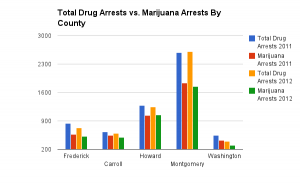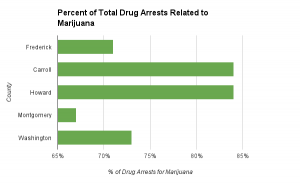By Erin Droneburg
Beginning in October 2014, Maryland will decriminalize use or possession of up to ten grams of marijuana. This offense will be lowered from a criminal offense to a civil offense.
Any person who is found with a decriminalized quantity of marijuana will be issued a civil citation. The citation will come with a monetary penalty, all of which will be allotted to the Department of Health and Mental Hygiene.
The law will bring a good deal of change for the state as a whole, especially within law enforcement agencies.
Captain Tim Clarke of the Frederick County Sheriff’s Department says that the new law will alter the way that deputies carry out drug-related responses. He also points out areas of the bill that are not specific enough, which make adapting agency procedures more difficult.
One change will change current conditions that provide probable cause for conducting searches.
Now, Clarke says, the odor of burnt marijuana is probable cause to search for drugs; with the new law, this will no longer be the case. Paraphernalia will still warrant probable cause for a search as the bill does not legalize or decriminalize its possession.
Another aspect of probable cause involves the K-9 units. One question that Clarke has is, “will [a dog’s] alert on a vehicle give us the right to search a car, which it does now?”
Law enforcement dogs are trained to alert an officer of drug presence. The issue arises as a matter of whether a dog’s alert would warrant a search if there is no way of determining what drug and in what quantity the dog is sensing.
Should a judge formally rule that a police canine does not have the ability to distinguish between drugs, their alert will still be probable cause for a search, Clarke says.
Currently deputy patrol cars are not outfitted with digital scales, and Clarke says that officers are typically given a guideline as to what approximately 10 grams looks like.
However, marijuana is produced in many strains, each with varying properties; ten grams of one strain can look vastly different from another depending on the densities of each strain. Therefore, a visual guide of marijuana quantity would be unreliable for correctly assessing the amount in question.

The bill does not address in detail what is to be included in the weight. Clarke says if packaging is to not be included, the process of weighing loose marijuana on a scale is more difficult than if it were in a container.
Budgets for fiscal year 2015 have not been finalized, but Clarke says it is unlikely that additional funding for scales will be factored in. Renee Williar, Frederick County Sheriff Department Director of Fiscal Services, says the budget does, however, include funds to update the computer systems in patrol cars.
Should scales be needed, Clarke notes once the budget is approved, the department has “the ability to move funds from different categories if we see a need” or can make an appeal to the county government for additional funding.
Sergeant Jennifer Bailey of the Frederick County Sheriff’s Department says that crime rates have increased “across the board” in Frederick County in the past year, following national trends. She says department employees try to “direct resources the best they can.”

Source: 2012 Maryland Unified Crime Report
Bailey adds that Frederick crime statistics are around half the national average, which makes Frederick a safe place to live and work.
“Marijuana is the most prevalent drug in Frederick County,” Clarke says.

Many proponents of marijuana say legalization will open up more time for law enforcement agencies to focus on other, more serious crime.
Clarke says the Frederick Sheriff’s Department will be combatting marijuana in Frederick with as much vigor as before, if not more.
The budget for fiscal year 2015 is slated to bring enough funding to open five new positions within the department, Williar says. With a greater presence in the public, the department will be able to keep enforcement efforts consistent.
“Nine times out of ten” marijuana is also found while confiscating harder drugs like heroin, according to Clarke. Thus, the department will spend the same amount of time on combatting all illegal drugs.
Decriminalization will impede a deputy’s ability to find other illegal drugs, Clarke adds. If a person is found with fewer than ten grams of marijuana, there is no probable cause to further search and potentially find other illegal substances.
Within the Frederick County Sheriff Department, Clarke says that “all law enforcement is against” the decriminalization. The bill is going to impede the department in carrying out their duties, he adds.
In order to create new procedures according to the new law, Clarke says the department is going to draw on its resourcefulness and adapt as needed.
He says that down the road, steps may be taken to pass local ordinances to counteract ways the bill impedes the department’s law enforcement. For instance, the bill does not ban smoking marijuana in public, which is an issue that could be resolved with local regulations.
Maryland will be joining 17 other states that have decriminalized recreational marijuana, according to Michael Winter of USA Today. Legislators are coming to accept recreational marijuana use and how its regulation can benefit state infrastructure as well as opening space for enforcing more serious crime.
As state drug policies on marijuana are changing throughout the country, there is a chance that Maryland could further decriminalize, or even legalize, marijuana use. Clarke says that should that day come, the Sheriff’s Department will once again adapt to new mandates.